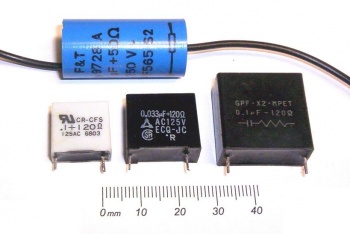Snubber
A snubber is a small device that reduces switch arcing, thus avoiding premature switch failure.
When to use a Snubber
Snubbers are used with inductive loads which cause switch arcing. Examples of inductive loads:
- Mains motors (eg fans)
- Large transformers
- LPF (low power factor) iron ballasted Fluorescent Lighting (these usually flash during starting)
Most fluorescent ballasts have a built in power factor correction capacitor (PFC), making them HPF (high power factor). These don't need snubbers. LPF iron ballast fittings (with no PFC capacitor) do need a snubber, or will destroy switches prematurely. Some LPF fittings have built in snubbers.
Thermostats
Snubbers reduce pitting and wear on bimetal thermostat contacts, thus eliminating a fairly common cause of setting drift. They also reduce the chance of them sticking on, again improving temperature control, reliability and longevity.
Electronics
Similar snubbers are also used in electronics, for example where a semiconductor switches off current to a relay coil.
When not to use a Snubber
A snubber compromises the degree of isolation a switch provides. A 0.1uF snubber can pass upto 7.5mA rms on 240v mains, enough to give a serious shock, thus snubbers make switched lives still live when switched off. So snubbers are usually only used when required to ensure the switch continues to work properly. Hence the great majority of household switches don't have snubbers.
This much current can also be a functional problem in some cases. If a lightswitch feeding a 5w CFL were snubbed the light would dim rather than switch off.
The 7.5mA does not equal 7.5mA x 240v power waste, as the current is mostly capacitive. It's not recorded by domestic meters and does not result in any real power loss. Real power loss is a small fraction of a watt.
Component Values
The standard mains snubber is a 0.1uF capacitor and 100 ohm resistor in series, usually encased as one component. These values are good for the great majority of loads.
Low current loads and heavy loads may need different values. Heavy loads will need a larger capacitor and lower resistance, low current loads may need smaller capacitor and higher resistance.
The snubber is simply connected across the switch. In cases where an item is powered via multiple switches, the snubber can be connected across the appliance instead.
Don't be tempted to put a capacitor alone across the switch contacts. These do silence interference when the switch is opened, but create it when the switch closes, and pass very high peak currents through the switch on closing, much reducing reliability.
For 12v & 24v, 1uF & 10-20 ohms are better suited as general purpose values.
Switch rating
A 0.1uF 100ohm snubber can increase the momentary current flow through the switch contacts at switch on by upto 2.5A sometimes. The continuous current is too small to have any effect on a switch. Thus the snubber can be ignored when choosing a switch.
Help
If you don't know whether to use one, you can ask us in news:uk.d-i-y.
For most switches they're not needed. When they are needed, repeated premature switch failure will occur if one is not fitted, as well as sparking and radio interference when switching.
